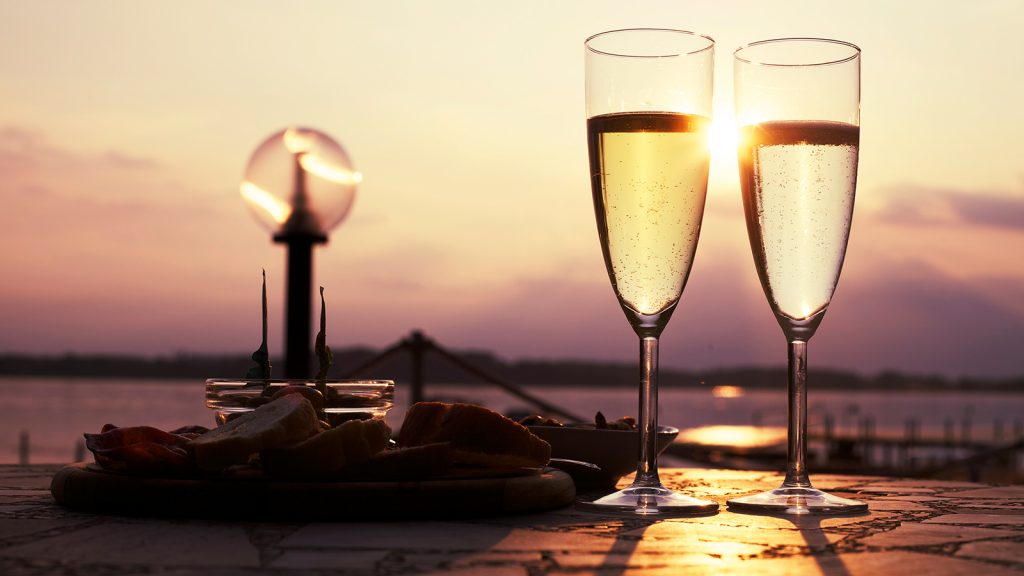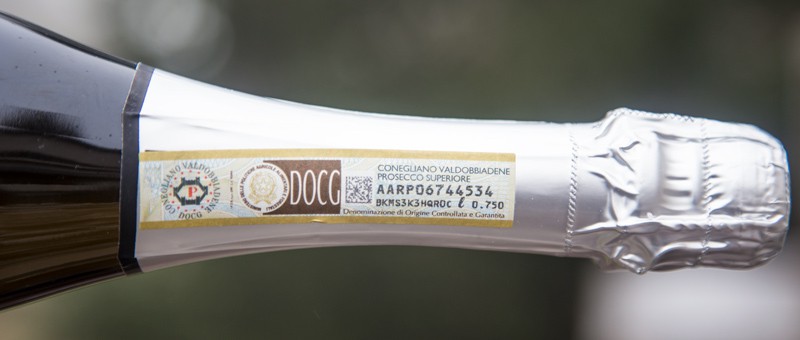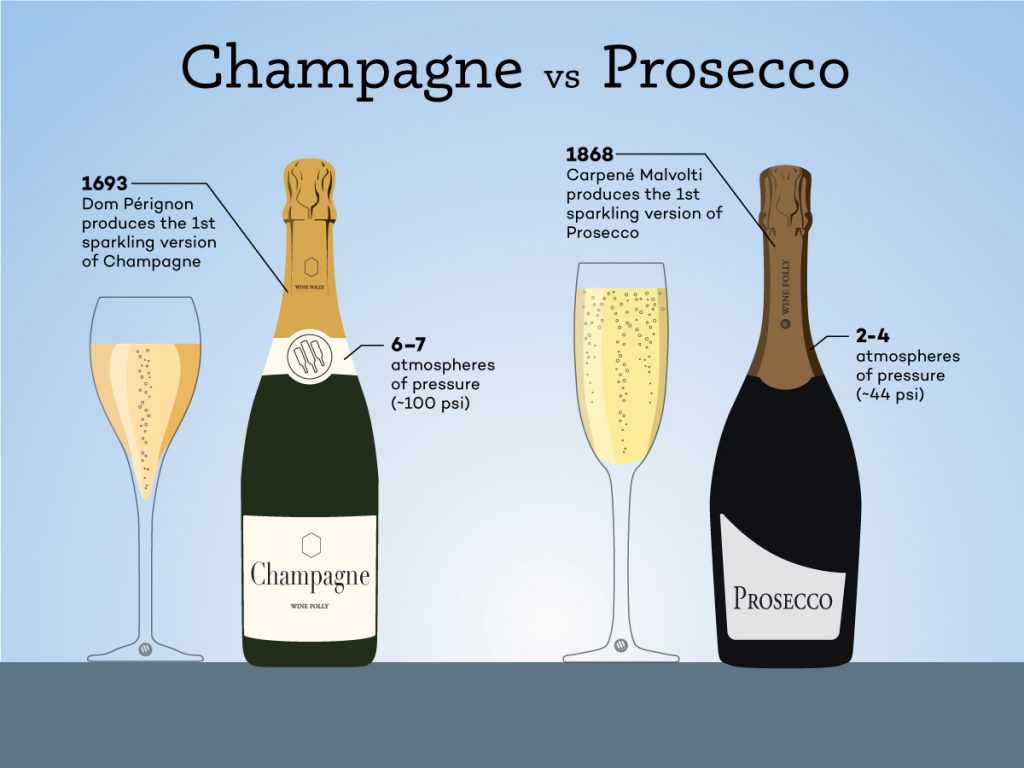Champagne VS Prosecco
Prosecco, well known as the key ingredient of the Bellini (along with white peach juice), has grown rapidly over the years in popularity and status. It has even eclipsed Champagne as a best-seller. With Prosecco’s distribution growing faster than ever before, there are more and more options to choose from, and finding the right bottle for charter guests can be a tricky decision.
But, before doing so, it helps to know how to tell the difference between Prosecco vs Champagne, alongside a few tricks of the trade to guarantee that your guests can’t get enough of it. 
What Makes A Wine ‘Champagne’ Or ‘Prosecco’?
Whether a wine can be labelled Champagne or Prosecco is entirely dependent on where the drink is produced. Wine can only be called Champagne when it originates from the Champagne region in France. In contrast, Prosecco hails from Italy.  When comparing the climates of the two places, we can see that Champagne is substantially more northerly than Prosecco. As a result, Champagne grapes ripen with increased acidity. Nonetheless, the Valdobbiadene region of Italy, where Prosecco is produced, has a distinct microclimate that is significantly cooler than the surrounding area (Valdobbiadene gets a lot of rain!). This aids in the production of crisp, delightful sparkling wines.
When comparing the climates of the two places, we can see that Champagne is substantially more northerly than Prosecco. As a result, Champagne grapes ripen with increased acidity. Nonetheless, the Valdobbiadene region of Italy, where Prosecco is produced, has a distinct microclimate that is significantly cooler than the surrounding area (Valdobbiadene gets a lot of rain!). This aids in the production of crisp, delightful sparkling wines.
Do Champagne & Prosecco Actually Taste Different?
You might think the two bubbly drinks may have very little that sets them apart in taste; however, Champagne and Prosecco actually have wildly different taste profiles.
In Champagne, the primary flavours consist of citrus, white peach, cherry, almond and toast. In contrast, Prosecco’s standout flavours include green apple, honeydew, honeysuckle, pear and fresh cream. 

The textures of the two are also distinct. Because Prosecco is made in huge tanks with lower pressure, the bubbles in Prosecco are lighter, frothier, and steadier than the fine and rapid bubbles found in Champagne.
Why Is Champagne More Expensive Than Prosecco?
Have you ever wondered why you can pick up a bottle of Prosecco for under £10, it requires a small fortune to splash out on Champagne? The main reason for the substantial difference in price is due to the different methods of production used.
The Reason Champagne Is So Expensive:
The main reason for the difference in price is the different methods of production. Champagne requires a conventional carbonation procedure (the ‘traditional’ method), in which the wine sparkles as it is bottled. Prosecco, on the other hand, carbonates in stainless steel vats, which requires less time and money.
Another reason aside from the production process is Champagne’s status as a premium item drives up pricing. Prosecco’s reputation as a value sparkler, on the other hand, makes it more inexpensive. Exceptional Prosecco wines do exist, however, in the minds of consumers it doesn’t have the same value as Champagne.
How To Spot A Good Bottle Of Bubbly?
*For Prosecco, check for The DOCG label
First, look for the DOCG label. The Consortium for the Protection of Prosecco Conegliano Valdobbiadene DOCG is an organisation that protects the tradition, heritage, and image of the production of Prosecco Superiore in a small, but prestigious area between the small towns of Conegliano and Valdobbiadene. If you can’t remember the names of the towns, the DOCG label will guarantee that it comes from the right area. Just an hour’s drive north of Venice, the picturesque countryside is dotted with vineyards perched on the side of hills so steep they seem to defy gravity.
The area is so beautiful that it applied to be a UNESCO World Heritage site. The constant moderate temperatures in winter, combined with dry, hot summers make this the perfect landscape for the Glera grape. The wine variety is native to the Veneto region, which makes up 85% of Prosecco.  When looking for a good bottle of bubbly, it’s important to look out for the DOCG label. The DOGC is an organisation that protects the tradition, heritage and image of the production.
When looking for a good bottle of bubbly, it’s important to look out for the DOCG label. The DOGC is an organisation that protects the tradition, heritage and image of the production.
Giancarlo Vettorello, Director of the Consortium Conegliano Valdobbiadene:
“What makes the DOCG Prosecco Superiore so special is the land. It’s the number one factor in distinguishing our Prosecco from other sparkling wines and translates directly into the freshness, taste, and bouquet that our wines are known for. You can plant chardonnay grapes anywhere, but it won’t become champagne. In the same verse, our land and its unique climate, along with our long heritage and traditional production methods make it a unique wine.”
Texture. A Sign Of Quality
When tasting sparkling wines, there are things you can look out for to identify the quality of the drink. Regarding Champagne, the smaller the bubbles the better. Smaller bubbles result in a smoother consistency which tends to be more pleasant on the palette when drinking.
When compared to Prosecco, Champagne generally has a more refined texture with elegant bubbles – this is due to the much longer ageing process Champagne undergoes compared to Prosecco.
Is The Bottle Dark In Colour?
A simple way to spot a good bottle of bubbly is the bottle used. It should be made of dark, thick glass and dark green in colour. This is because light exposure will transform the wine into stale grape juice if the glass isn’t thick and coloured enough to avoid it. 
If you enjoyed learning the difference between Prosecco vs Champagne, discover the top 5 luxury wines for a romantic yacht charter by clicking here.
To keep up to date with the latest Superyacht Content News, click here.
Sign up to our Newsletter below:









.gif)


.gif)






